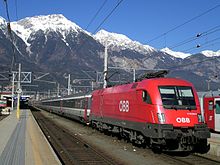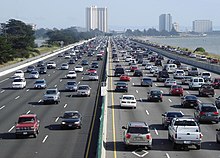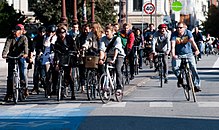Transport
![]()
This article explains traffic in the sense of transport, for other meanings see Traffic (disambiguation).
![]()
This article or section needs revision. More details should be given on the discussion page. Please help improve it, and then remove this tag.
Traffic (abbreviated: Verk.) is the movement of people and material goods as well as messages, information, energy and water. Certain types of traffic determine the form of movement (transport), objects (entities) and the transport system, e.g. road traffic, passenger traffic, freight traffic, message traffic, individual traffic, means of transport or traffic route.

air traffic near London

Shipping traffic off Hamburg

Rail transport in Innsbruck

Road Traffic in Berkeley, California
.JPG)
Foot traffic in Vienna

Cycling in Copenhagen
_(14596082918).jpg)
General
In a transportation network, objects are moved along edges or routes of a transportation infrastructure.
Transport is considered from various transport science points of view. Traffic engineering primarily focuses on the technical side of traffic. The sociology of transport explores the background of transport under the heading of mobility: transport makes spatial mobility possible. Traffic psychology looks at the motives of traffic and the behaviour of road users. Traffic pedagogy deals with the rules of traffic, with its potential dangers, with safe and compatible coexistence in traffic life and the methods to achieve this. Traffic geography deals with the spatial relationships of traffic. Transport policy is a field of action of the state to shape traffic. In Germany, traffic causes about one third of the annual CO₂ emissions.
History
→ Main article: History of transport and transport history
In the 19th century, the economic and technical differentiation of means of transport began. They were grouped into transport branches according to their typical characteristics, such as the railways (= set of all transport systems and their components, the characteristic of which is the tracking of the rail vehicles in the wheel-rail system, i.e. driving at spatial intervals, etc.). The transport systems were then also analysed from a macroeconomic point of view. As before the consideration of an entire national economy, the focus of interest here was the movement of all units of a delimited transport system. The set of all movements of rail vehicles was then called railway or rail traffic. Similarly, terms such as road traffic, air traffic, shipping traffic, communication traffic or postal traffic came into being. In English, this meaning is found in the term "traffic".
Questions and Answers
Q: What is transport?
A: Transport is the movement of people or things from one place to another.
Q: What are the three components of transport?
A: The three components of transport are infrastructure, vehicles and operations.
Q: Who builds and pays for infrastructure?
A: Infrastructure such as roads and railways is usually built by governments and paid for by taxes from citizens of a country or region.
Q: What types of vehicles travel on infrastructure?
A: Vehicles that travel on infrastructure include cars, trucks, trains and airplanes.
Q: How do vessels travel on canals?
A: Vessels such as boats, ferries, and barges use docks and seaports to travel on canals.
Q: What does air traffic control do in relation to transportation?
A: Air traffic control is part of operations which controls the system by regulating flight paths for airplanes in the sky.
Q: What other types of regulations are used to control transportation systems? A: Other types of regulations used to control transportation systems include tolls, fuel taxes, and traffic laws.
Search within the encyclopedia